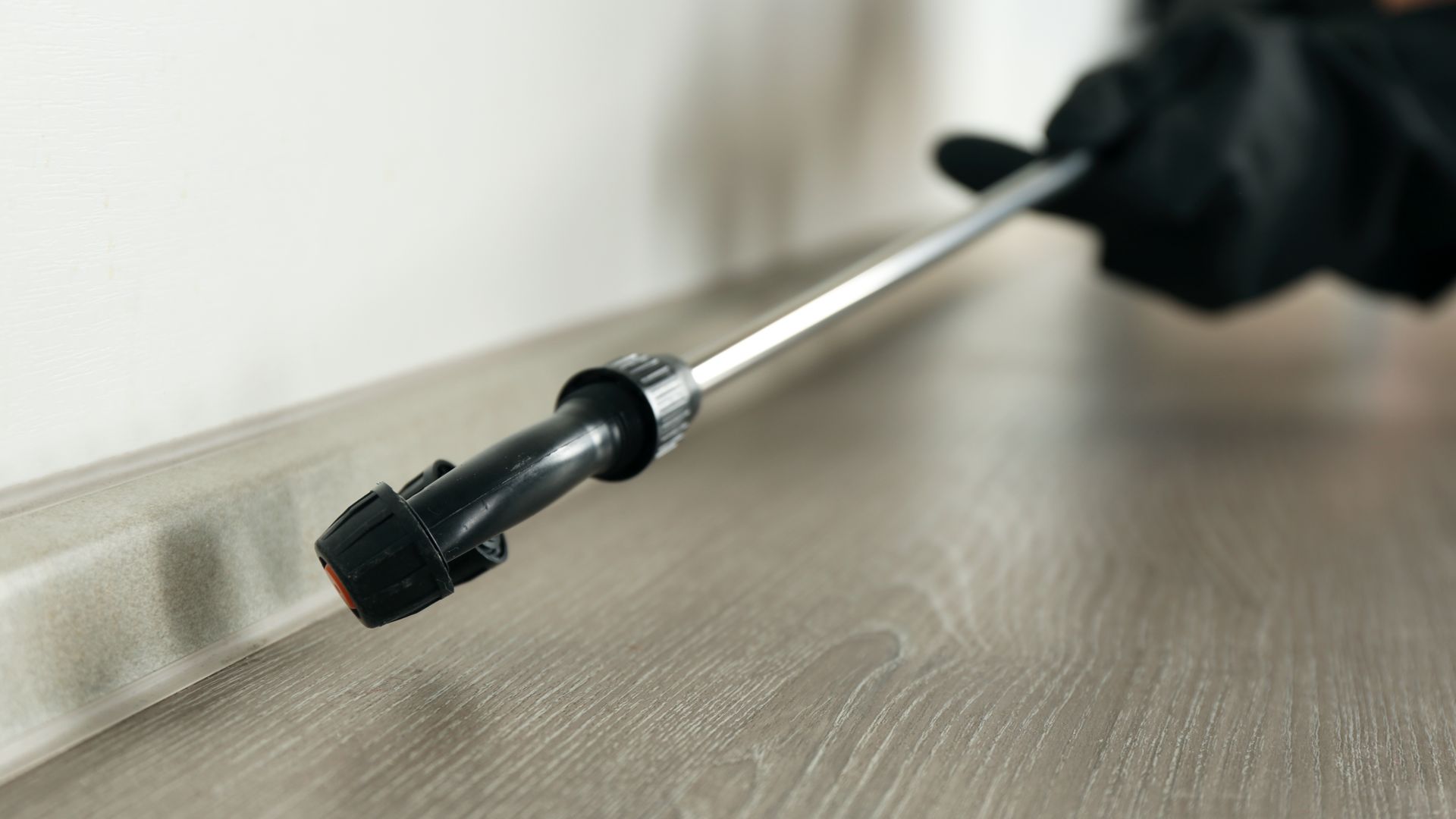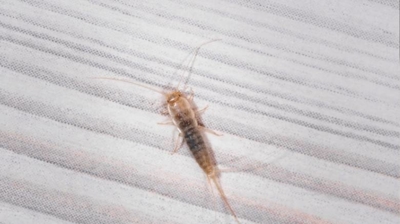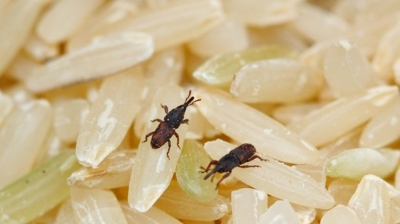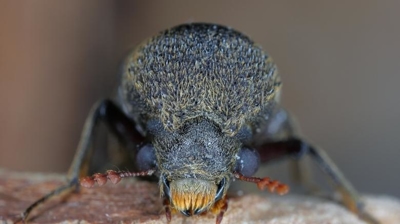
Mud Dauber Wasp Control Services
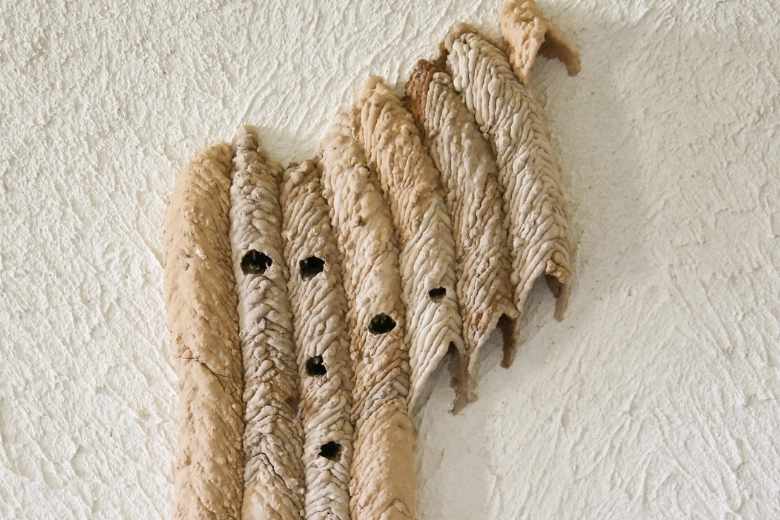
Are Mud Dauber Wasps Harmful?
Mud dauber wasps are generally considered among the least aggressive types of wasps, but they can still pose several potential problems or be considered harmful in specific contexts:
- Stinging Risk (Though Low): While mud daubers are solitary and rarely sting, they can deliver a painful sting if handled, threatened, or accidentally trapped against the skin. For individuals allergic to wasp venom, even a single sting can cause a severe reaction, making their presence a concern near homes or businesses.
- Structural and Aesthetic Damage: Mud daubers build nests from mud, often attaching them to walls, ceilings, eaves, porches, and other structures. These nests can stain or damage surfaces, especially painted or finished areas. Over time, repeated nesting can cause unsightly buildup and require costly cleanup or repainting.
- Nuisance Around Entry Points: Mud daubers frequently choose sheltered spots such as attics, garages, sheds, or door frames to build their nests. Their presence around entry points can cause discomfort for homeowners, employees, or customers—particularly in commercial settings where wasp activity is unwelcome.
- Clogging and Maintenance Issues: In some cases, mud daubers build nests inside vents, air intakes, electrical boxes, or outdoor equipment like boat or lawnmower engines. These obstructions can interfere with airflow, cause mechanical issues, or increase maintenance costs.
- Potential Attraction of Other Pests: Abandoned mud dauber nests may attract secondary pests such as carpet beetles, spiders, or other insects looking for shelter. Over time, this can contribute to broader pest management challenges around a property.
- Business Image and Liability Concerns: For commercial properties—particularly restaurants, offices, or retail spaces—the presence of visible wasp nests can negatively impact customer perceptions of cleanliness and safety. In outdoor venues or hospitality settings, the risk of a sting, even if minimal, also poses potential liability concerns.
Learn more: Do Mud Dauber Wasps Sting?
Mud Dauber Wasp Control
Hiring our professional pest control for mud dauber wasps is the most effective and safest way to handle infestations of these wasps, especially when nests are located in hard-to-reach, high-traffic, or sensitive areas. While mud daubers are typically non-aggressive, their nesting behavior and potential to sting still make our expert management worthwhile. Here’s why our professional pest control is the superior choice:
- Safe and Thorough Nest Removal: Our professionals have the proper tools, training, and protective equipment to remove mud dauber nests safely, even from high eaves, attics, or utility areas. Attempting removal without expertise can lead to unnecessary stings or damage to building surfaces.
- Accurate Identification of Wasp Species: Homeowners often mistake mud daubers for more aggressive wasps, like yellowjackets or paper wasps. Our pest control technicians can accurately identify the species, ensuring the correct treatment approach. Proper identification also prevents overuse or misuse of insecticides.
- Prevention of Recurring Nests: Our professionals don’t just remove the current nest—we identify the conditions that attract mud daubers in the first place. This may include sealing small entry points, treating surfaces to discourage rebuilding, and addressing sources of standing water or prey insects (like spiders).
- Protection Against Structural and Aesthetic Damage: Our technicians remove nests carefully to minimize surface staining and can apply preventive treatments to stop new ones from forming. This preserves your property’s appearance and prevents costly cleaning or repainting.
- Comprehensive Inspection and Risk Assessment: Our pest control experts inspect surrounding areas to ensure no hidden or secondary nests are forming. We can also detect other wasp or pest activity that may go unnoticed by untrained eyes.
- Reduced Liability and Peace of Mind: For businesses, our professional wasp control reduces liability risks from potential stings and improves customer safety. For homeowners, it provides peace of mind knowing that nests have been fully removed and the environment is safe.
- Eco-Friendly and Targeted Treatments: We use environmentally responsible methods and only apply treatments when necessary. This ensures effective control without harming beneficial insects or surrounding vegetation.
Our professional pest control delivers safe, efficient, and long-lasting relief from mud dauber problems—protecting both people and property while preventing future infestations.
Learn more: How To Get Rid Of Mud Dauber Wasps
What Do Mud Dauber Wasps Look Like?
Mud dauber wasps have a very distinctive appearance that makes them easy to recognize compared to other wasps. They are slender, elongated, and have a narrow, thread-like “waist” connecting their thorax and abdomen—one of their most defining features. Here’s what mud dauber wasps look like:
- Body Shape and Size: Mud daubers are solitary wasps with long, thin bodies measuring about ½ to 1 inch (12–25 mm) in length. Their extremely narrow waist gives them a wasp-like, almost spider-like appearance when in flight.
- Coloration: Their color depends on the specific species, but common varieties include Black and Yellow Mud Daubers (shiny black body with bright yellow markings on the legs and thorax), Blue Mud Daubers (metallic blue or bluish-black with a sleek, iridescent sheen, and Organ Pipe Mud Daubers (solid black and more robust-looking, often nesting in tubular “organ pipe”-shaped formations).
- Wings: Their wings are typically dark, smoky, or translucent, folding flat over their back when at rest. The Blue Mud Dauber’s wings often shimmer with a metallic tint.
- Antennae: They have medium-length, curved antennae that help them navigate and detect prey such as spiders, which they paralyze to stock their nests.
- Flight Behavior: Mud daubers have a graceful, almost hovering flight pattern and are often seen flying slowly around eaves, porches, garages, and sheds while searching for nesting sites or collecting mud.
- Nest Identification (Visual Clue): Even if you don’t see the wasp itself, its mud nests are a clear indicator. These nests appear as small tubes, lumps, or clusters of mud—often on walls, ceilings, or in corners of sheltered areas.
Mud daubers are slender, solitary wasps with long, thin waists, metallic blue or black-and-yellow coloring, and a calm flight pattern. Their appearance and mud-built nests make them easy to distinguish from more aggressive social wasps.
Where Are Mud Dauber Wasps Found?
You are most likely to find mud dauber wasps in quiet, sheltered areas that offer protection from rain and wind, as well as easy access to both mud and spiders, which they use to build and stock their nests. These wasps are not social—they live and work alone—so you’ll typically find individual nests rather than large colonies. Here are the most common places mud daubers tend to occupy:
- Around Building Exteriors: Mud daubers often construct nests on vertical surfaces such as walls, eaves, door and window frames, soffits, and fascia boards. They prefer dry, shaded areas under overhangs or porches where their nests are protected from direct sunlight and rainfall.
- Inside Garages, Sheds, and Barns: These locations provide the perfect combination of shelter and access to mud sources outside. You’ll often find nests attached to rafters, beams, or the corners of walls and ceilings, particularly where spiders are common.
- Attics, Basements, and Crawl Spaces: Mud daubers can enter through small gaps, vents, or openings and build nests in low-traffic indoor spaces. They may also use existing holes or cracks in masonry, brick, or wood for nest attachment.
- Under Decks, Porches, and Eaves: These areas are prime nesting spots due to their protection from the elements and abundance of insect prey. You might notice clusters of dried mud tubes or small clay-like structures tucked away beneath the boards.
- In or Around Outdoor Equipment and Fixtures: Mud daubers sometimes build nests in light fixtures, electrical boxes, vents, and pipes, or even inside unused lawn equipment, grills, mailboxes, and boats. These hidden nests can cause blockages or maintenance issues.
- Bridges, Culverts, and Structural Crevices: In more rural or commercial settings, you may find mud dauber nests on concrete or metal structures, such as bridge undersides or warehouse beams, where moisture and shade create ideal conditions.
- Near Water and Mud Sources: Since they need mud to build their nests, mud daubers typically stay within a short distance of moist soil, puddles, or irrigation areas. If your property has a steady water source, it’s more likely to attract these wasps.
Mud dauber wasps prefer quiet, protected environments near both mud and spider populations. They often go unnoticed until their distinctive mud nests appear on surfaces around homes or businesses.
What Do Mud Dauber Wasps Eat?
Mud dauber wasps have a fascinating and efficient diet that reflects their dual lifestyle as both hunters and pollinators. Their feeding habits differ between adults and larvae, and understanding these distinctions helps explain the role of these wasps in the ecosystem and how they interact with their environment.
- Adult Mud Daubers – Nectar Feeders: Adult mud daubers primarily feed on nectar, honeydew, and plant juices. They are often seen visiting flowering plants, much like bees, where they drink sugary liquids to fuel their flight and nest-building activities. This diet gives them the energy needed to collect mud, hunt prey, and construct their characteristic tube-like nests. Although they are not major pollinators, they do contribute to pollination incidentally while feeding on flowers.
- Larval Mud Daubers – Spider Predators (via Parental Provisioning): The larvae of mud dauber wasps are carnivorous, but they don’t hunt for themselves. Instead, the adult female hunts and paralyzes spiders using her sting—never killing them outright. She then carries these immobilized spiders back to her nest and seals them inside individual mud cells with a single egg. When the egg hatches, the larva feeds on the fresh, living spiders until it’s ready to pupate.
- Types of Spiders Targeted: Mud daubers are highly selective in their hunting. Depending on the species, they favor certain types of spiders. The Black and Yellow Mud Dauber typically hunts orb-weaver spiders, which spin large circular webs. The Blue Mud Dauber often targets black widow spiders, making it a natural predator of a potentially dangerous pest. The Organ Pipe Mud Dauber tends to collect a range of ground or web-building spiders found around structures. Because of their spider-hunting behavior, mud daubers can help regulate spider populations around homes, sheds, and outdoor areas. While their nests may be a nuisance, their predatory activity can actually reduce encounters with venomous spiders such as black widows.
Adult mud daubers feed on nectar and sweet plant fluids, while their larvae feed exclusively on spiders supplied by the female. This combination of plant-based and predatory feeding habits makes mud daubers unique among wasps—both a potential nuisance and a beneficial natural control agent.
Mud Dauber Wasp Life Cycle
The mud dauber wasp has a well-defined life cycle consisting of four stages—egg, larva, pupa, and adult—each with distinct behaviors and environmental requirements. These solitary wasps have a relatively short but efficient lifespan, and while their reproductive potential isn’t as high as social wasps, their survival strategy ensures consistent population renewal:
- Egg Stage: After constructing a mud nest composed of several tubular cells, the female mud dauber places a single egg inside each cell. Before sealing it, she provisions the cell with a supply of paralyzed spiders—usually between 5 and 25 per cell, depending on size. These spiders serve as fresh food for the developing larva. Once stocked, she seals the chamber with a mud cap and moves on to build another.
- Larval Stage: Within a few days, the egg hatches into a larva (grub-like in appearance). The larva consumes the paralyzed spiders provided by the mother, growing rapidly as it feeds. The larval stage generally lasts 1 to 3 weeks, depending on temperature and food availability. During this time, the larva remains inside the cell, safe from predators and environmental conditions.
- Pupal Stage: After finishing its supply of spiders, the mature larva spins a silken cocoon within the mud cell and enters the pupal stage. Inside the cocoon, it undergoes metamorphosis—transforming from a larva into a fully developed adult wasp. The pupal period can last several weeks to several months, particularly if the wasp overwinters in this stage. Many mud daubers that develop in late summer remain dormant through the winter and emerge in spring.
- Adult Stage: When development is complete, the adult mud dauber chews its way out of the dried mud cell, leaving behind a small round exit hole. Adult mud daubers emerge primarily during late spring and summer, depending on climate. Once emerged, they immediately begin feeding on nectar and seeking suitable sites to build nests and reproduce.
- Life Span: The average adult lifespan of a mud dauber is relatively short, typically ranging from a few weeks to about two months, though it can vary by species and environmental conditions. Most adults die off before winter, while their offspring overwinter as pupae inside sealed mud cells. However, when you include the full development period (egg to adult), the total lifespan of an individual mud dauber may extend from several months up to nearly a year, depending on when it was laid and when it emerges.
- Reproductive Potential: Mud daubers are solitary reproducers, meaning each female is solely responsible for nest construction, hunting, and provisioning her offspring. Despite lacking the cooperative behavior of social wasps, they reproduce efficiently due to their persistence and ability to complete multiple nests per season. A single female may build up to 15–25 nests during her adult life, each containing several individual cells (typically 6–15). Each cell produces one offspring, meaning one female can generate dozens of new wasps in a single season under favorable conditions. Males do not assist in nest construction or provisioning; their sole role is to mate, after which they usually die shortly thereafter.
Mud dauber wasps have an efficient solitary life cycle built around precision, independence, and environmental adaptation. Their ability to produce numerous offspring without forming colonies allows them to thrive while maintaining relatively low population densities.

Hear From Our Happy Customers
-
"Great Communication"
Tech was on time, communication was great, and he accommodated my needs.
- Alonzo W. -
"Very Knowledgeable"
The tech that arrived was courteous, professional, and very knowledgeable. He was Great.
- Uerial I. -
"Exceeds Expectations"
I can’t say enough positive things about this company... The tech that came out, Jarvis went above and beyond my expectations. Thank you guys, I will continue using your services.
- Jake M. -
"Professional & Considerate"
I’m pleased with Miche services. Jarvis came today. Professional and considerate. Thank you!
- Judy B. -
"Wonderful Service"
Wonderful service. Jarvis is great. Took care of everything I needed. Thank you!
- Henry P. -
"Fantastic & Patient"
Jarvis was fantastic and patient. He answered my questions with an in-depth explanation and addressed all of my areas of concern. Would love for him to be my assigned tech going forward. Well done!
- Yonnette M.
